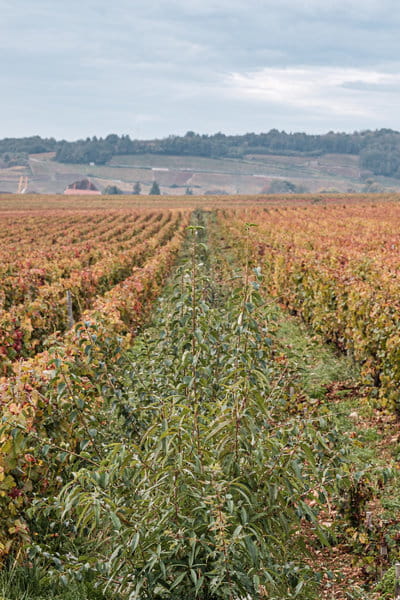Agroecology is said to mitigate the risks of climate change. Are you pursuing this at Clos de Tart?
Yes, we are indeed! We've actually planted a 350-metre hedge in the heart of the Clos which contains a dozen different plant species (blackthorns, wild pear trees, peach trees, field maples, Sainte Lucie cherry trees....). Other hedges similar in nature as well as trees are already being planned for other parts of the vineyard. These hedges have several benefits for the vines, helping them adapt to the changing circumstances whilst simultaneously preserving the natural environment:
• They increase biodiversity by providing a habitat for grapevine auxiliary fauna (thrips, ladybugs, predatory mites...), extending the flowering period providing pollen and nectar for pollinating insects and encouraging the passage of birds and other fauna,
• They encourage the development of mycorrhiza, a symbiotic relationship between the vine and soil fungi, which brings the vine phosphorous and other mineral elements.
• They provide beneficial shade for the vines which is all the more welcome in the increasingly hot and dry summers here in the Côte d'Or
• They bring back increased landscape diversity
For example, one of the species we have planted, the hazelnut tree, is an ideal habitat for helpful predators such as ladybugs. They actually help to reduce aphid populations, which harmful to the vine. As it blooms quite early in the season, it gives them valuable nourishment that helps them see out the end of the winter. Next winter we will install nesting boxes in the Clos that will provide shelter for birds, such as tits, as well as bats.
Do you have any other projects that aim to help the vines resist?
We have been carrying out grafting experiments in two rows on two different terroirs in the Clos - La Forge and Ballonge 2 where we attached new scions to old rootstocks. This is a very interesting project as the new scions were grown in our very own vine nursery, which is quite rare in the region. Indeed, to preserve the genetic diversity and quality of the old pinot noir vines on the Estate, we have curated a pool of fifty different individual Pinot Noir vines, which is the happy result of twenty years of practicing massal selection. Each vine has its own particular virtues (bud fruitfulness, vigour, vine balance ...) thus increasing the overall quality level of the plant material. Crucially, these special scions are grafted onto the old rootstocks, as the young plants benefit from their highly-developed root system. Consequently, these vines have better access to water and nutrients in particularly hot and dry years (which are becoming a more common occurrence) and have better chances of survival. Grafting is very stressful for the plant so we were especially pleased with our success rate of 80%. Therefore, we decided to extend this programme in 2022 to cover four rows in these two zones. Whilst this project requires a lot of work (constant vigilance in the vineyard, regular watering...) and the benefits are not immediate (the first fruit comes only three years after the grafting), we are convinced that this method will increase the quality of the grapes and ultimately the finished wine.
This year we have launched a project with the INRAE (French public research institute dedicated to agricultural science) in Colmar looking at the impact of viruses in the vineyard and the dreaded Grapevine Fanleaf Virus in particular.
What is on the cards for 2022?
We hope to finish the renovation work at the Estate this year! So along with the improvements to the technical installations and equipment, we have also renovated the offices, tasting room, inner courtyard and the emblematic 'Salle du Vieux Pressoir'. We are looking forward to welcoming our guests in the near future!
